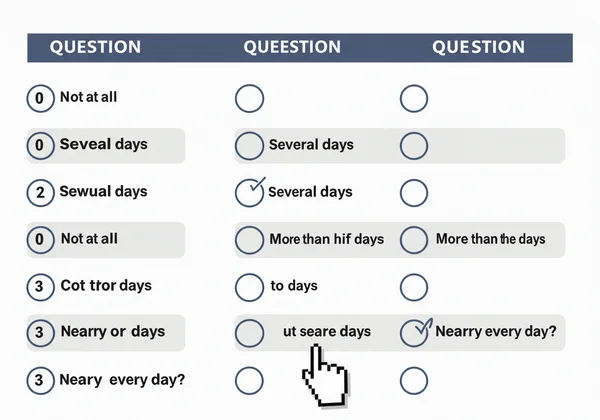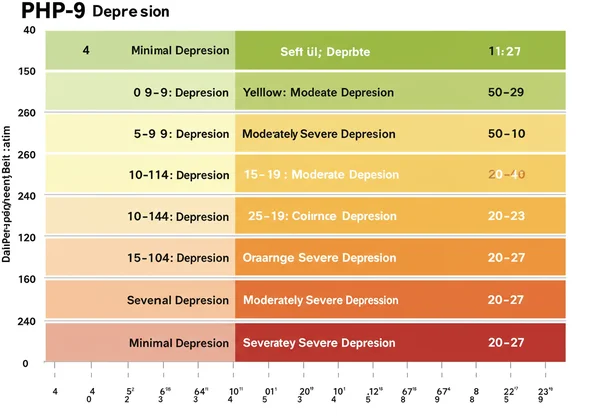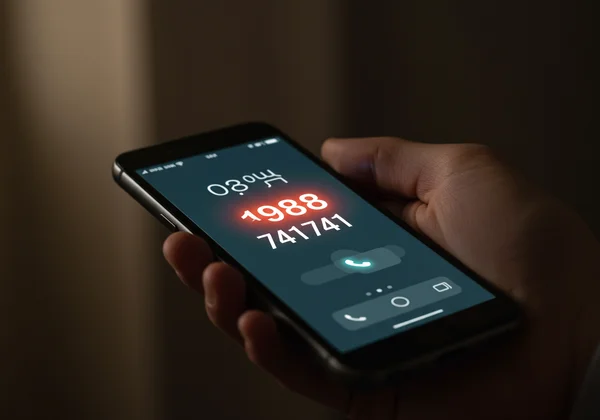PHQ-9 Score Guide: Understanding Your Depression Score
Feeling overwhelmed or confused by your PHQ-9 score? You're not alone. Many people take the Patient Health Questionnaire-9 and then wonder, what does the phq9 score mean for their emotional health? This guide will break down what each number signifies, helping you understand your current state and what thoughtful steps you might consider next. Your score isn't a definitive label, but a guide, helping you navigate your current emotional state.
What is PHQ-9 Scoring & How is it Calculated?
The Patient Health Questionnaire-9 is a widely recognized self-report questionnaire used to screen for depression severity. It's a simple yet powerful tool, comprising nine questions that mirror the nine diagnostic criteria for major depressive disorder from the DSM-IV. Understanding how to score phq 9 is the first step in interpreting your results.
The 9 Questions and Their Point Values
Each of the nine questions on this assessment asks about how often you've been bothered by certain problems over the last two weeks. Your answer to each question is assigned a numerical value:
- 0 (Not at all)
- 1 (Several days)
- 2 (More than half the days)
- 3 (Nearly every day)
These questions cover symptoms such as little interest or pleasure in doing things, feeling down or depressed, trouble sleeping, feeling tired or having little energy, changes in appetite or weight, feelings of worthlessness or guilt, trouble concentrating, moving or speaking slowly or being fidgety, and thoughts of self-harm.
Summing Your Answers: Getting Your Total PHQ-9 Score
To get your total score, you simply add up the points from your responses to all nine questions. The lowest possible score is 0 (if you answer "Not at all" to every question), and the highest possible score is 27 (if you answer "Nearly every day" to all nine questions). This total score is then used to determine the severity level of depressive symptoms you might be experiencing. It's a straightforward process, offering an immediate look at your current emotional state. If you're ready to take the assessment, you can easily start your PHQ9 on our website.

Decoding Your PHQ-9 Score Interpretation: From Minimal to Severe
Once you have your total score, the next crucial step is phq 9 score interpretation. This will place your results within a specific range, each corresponding to a different level of depression symptom severity. These phq 9 score ranges provide a framework for understanding your current emotional health.

0-4: Minimal Depression – Understanding the Absence or Mildness
A PHQ-9 score of 0 to 4 suggests minimal or no depressive symptoms. This is often an indicator of good emotional health. While you might experience occasional low moods, they generally do not significantly impact your daily life. It’s a good time to focus on maintaining your well-being through healthy habits like exercise, mindfulness, and strong social connections. Even with minimal symptoms, engaging in self-care practices is always beneficial.
5-9: Mild Depression – Recognizing Subtle Signs and Self-Care
If your score falls between 5 and 9, it indicates mild depression. You might be noticing subtle changes in your mood, energy levels, or interest in activities. These signs, while not severe, are worth acknowledging. This range is an excellent opportunity to proactively engage in self-care strategies. Consider exploring stress reduction techniques, improving sleep hygiene, or increasing physical activity. It's also a good moment to reflect on what might be contributing to these feelings and decide if seeking some guidance could be helpful.
10-14: Moderate Depression – When to Consider Professional Guidance
A PHQ-9 score of 10 to 14 suggests moderate depression. At this level, symptoms are more noticeable and might be affecting your daily functioning, relationships, or work. This is a point where considering professional guidance becomes particularly important. A mental health professional can offer tailored support, whether through therapy, lifestyle adjustments, or other interventions. Early intervention can make a significant difference, and many find relief and strategies for coping by speaking with someone. Our platform provides a confidential assessment that can be a valuable starting point for this conversation.

15-19: Moderately Severe Depression – Understanding Significant Impact
A score of 15 to 19 indicates moderately severe depression. Symptoms are likely prominent and significantly impacting various aspects of your life. You might find it challenging to engage in daily tasks, maintain your routine, or experience joy. It's crucial to seek professional help at this stage. Mental health professionals can provide comprehensive assessments and develop effective treatment plans to support you through these challenges. Reaching out for help is a brave and self-compassionate step. Take the first step and assess your emotional health today.
20-27: Severe Depression – Prioritizing Immediate Support
A PHQ-9 score between 20 and 27 signifies severe depression. At this level, symptoms are intense and pervasive, severely affecting your ability to function. Immediate professional support is crucial. This might involve urgent consultation with a doctor, a psychiatrist, or another mental health specialist. In some cases, hospitalization may be necessary to ensure safety and provide intensive care. It's important to remember that severe depression is treatable, and help is available.
The Critical Importance of PHQ-9 Question 9: Thoughts of Self-Harm
While all nine questions on this assessment are important for gauging overall depression severity, Question 9 holds a unique and critical significance: "Thoughts that you would be better off dead or of hurting yourself in some way."
Why This Question Requires Special Attention
A positive response to Question 9, regardless of the overall assessment result, should always be taken seriously. It indicates potential suicidal ideation, which requires immediate attention and support. This question is a direct inquiry into one of the most serious symptoms associated with depression, highlighting a need for urgency and care.
Immediate Steps to Take for Safety and Support
If you, or someone you know, indicates thoughts of self-harm on this questionnaire (or at any time), it is vital to act immediately. Here are crucial steps:
-
Reach out for help: Contact a crisis hotline, mental health professional, or emergency services right away.
-
National Suicide Prevention Lifeline: Call or text 988 (in the US).
-
Crisis Text Line: Text HOME to 741741.
-
Your local emergency services: Dial 911 (in the US) or your country's equivalent.
-
Stay with the person: If it's a friend or family member, stay with them and remove any means of harm.
-
Encourage professional help: Strongly urge them to seek professional help. Remember, safety is the absolute priority.

PHQ-9 Results: A Screening Tool, Not a Diagnosis
It’s crucial to understand that while this depression test is an excellent depression screening tool, it is not a substitute for a clinical diagnosis.
When a Professional Assessment is Your Essential Next Step
If your score indicates mild, moderate, or severe symptoms, or if you answered positively to Question 9, your essential next step should be to consult a healthcare professional. They can provide an accurate diagnosis, discuss your symptoms in detail, and help you develop a personalized treatment plan. Whether you're seeking to understand your results or ready to explore next steps, this platform offers a convenient online assessment to start your conversation with a professional. Remember, seeking help is a courageous step towards better mental well-being.
Taking the Next Step: Your PHQ-9 Score as a Guide
Your score is more than just a number; it's a valuable starting point for understanding your mental health. It offers a structured way to reflect on your experiences and provides a clear indicator of potential depressive symptoms. Whether your score suggests minimal concerns or points towards a need for significant support, remember that understanding is the first step toward action.
Our platform is committed to providing you with a reliable, free, and confidential tool for your assessment. Our tool offers immediate results and, if you choose, an optional AI-powered personalized report to give you deeper insights into your emotional health. We believe everyone deserves the tools to understand their inner world. Don't let uncertainty hold you back. Discover your score today and take a proactive step toward a healthier, happier you.
Frequently Asked Questions About PHQ-9 Scores
What does the PHQ-9 score mean?
This score indicates the severity of depressive symptoms you might be experiencing over the past two weeks. Scores range from 0 to 27, with higher scores suggesting more severe symptoms. For a complete understanding of what your score signifies, you can always interpret your PHQ9 through our detailed guide.
Can this assessment be used to diagnose depression?
No, this questionnaire is a screening tool for depression, not a diagnostic instrument. While it's highly effective at identifying potential symptoms, a formal diagnosis should always be made by a qualified healthcare professional after a comprehensive clinical evaluation.
What is a positive result on this assessment?
A score of 10 or greater on this questionnaire is typically considered a "positive screen" and suggests the presence of at least moderate depressive symptoms, warranting further evaluation by a healthcare professional. Any positive response to Question 9, regardless of the total score, also requires immediate attention.
How often should this assessment be done?
The frequency of this assessment can vary. It's often used at regular check-ups by healthcare providers, or you might choose to take it whenever you notice changes in your mood or emotional well-being. For monitoring purposes or as recommended by a professional, it can be done periodically. Our platform makes it easy to take the PHQ9 test anytime you need.
What age group is this assessment used for?
This assessment is primarily validated for use with adults (typically 18 years and older). While adaptations or similar questionnaires exist for adolescents, the standard tool is generally recommended for adult populations.